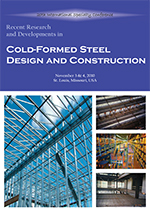Session Dates
03 Nov 2010
Keywords and Phrases
steel hollow sections||in-filled concretes||static test||cyclic test||FEM
Abstract
This paper presents a study on the flexural and cyclic behaviour of concrete filled steel hollow beam sections. The specimens in-filled with normal mix concrete, fly ash concrete, quarry waste concrete and low strength concrete (Brick-bat-lime concrete) and hollow steel sections were tested. Measurements of strains and deflections were made under two-point loading. A theoretical model was also developed to predict the moment carrying capacity. The capacities of the beams were compared with the ultimate capacity obtained using the international standards EC4-1994, ACI-2002 and AISC-LRFD-1999. The result of the experimental investigation showed that the moment carrying capacity increases based on the compressive strength of the filler materials. Energy absorption capacity also increase due to in filled materials. Analytical results show good agreements with experimental results.
Department(s)
Civil, Architectural and Environmental Engineering
Research Center/Lab(s)
Wei-Wen Yu Center for Cold-Formed Steel Structures
Meeting Name
20th International Specialty Conference on Cold-Formed Steel Structures
Publisher
Missouri University of Science and Technology
Document Version
Final Version
Rights
© 2010 Missouri University of Science and Technology, All rights reserved.
Document Type
Article - Conference proceedings
File Type
text
Language
English
Recommended Citation
Arivalagan, S. and Kandasamy, S., "Flexural and Cyclic Behaviour of Hollow and Concrete-filled Steel Tubes" (2010). CCFSS Proceedings of International Specialty Conference on Cold-Formed Steel Structures (1971 - 2018). 5.
https://scholarsmine.mst.edu/isccss/20iccfss/20iccfss-session5/5
Flexural and Cyclic Behaviour of Hollow and Concrete-filled Steel Tubes
This paper presents a study on the flexural and cyclic behaviour of concrete filled steel hollow beam sections. The specimens in-filled with normal mix concrete, fly ash concrete, quarry waste concrete and low strength concrete (Brick-bat-lime concrete) and hollow steel sections were tested. Measurements of strains and deflections were made under two-point loading. A theoretical model was also developed to predict the moment carrying capacity. The capacities of the beams were compared with the ultimate capacity obtained using the international standards EC4-1994, ACI-2002 and AISC-LRFD-1999. The result of the experimental investigation showed that the moment carrying capacity increases based on the compressive strength of the filler materials. Energy absorption capacity also increase due to in filled materials. Analytical results show good agreements with experimental results.



